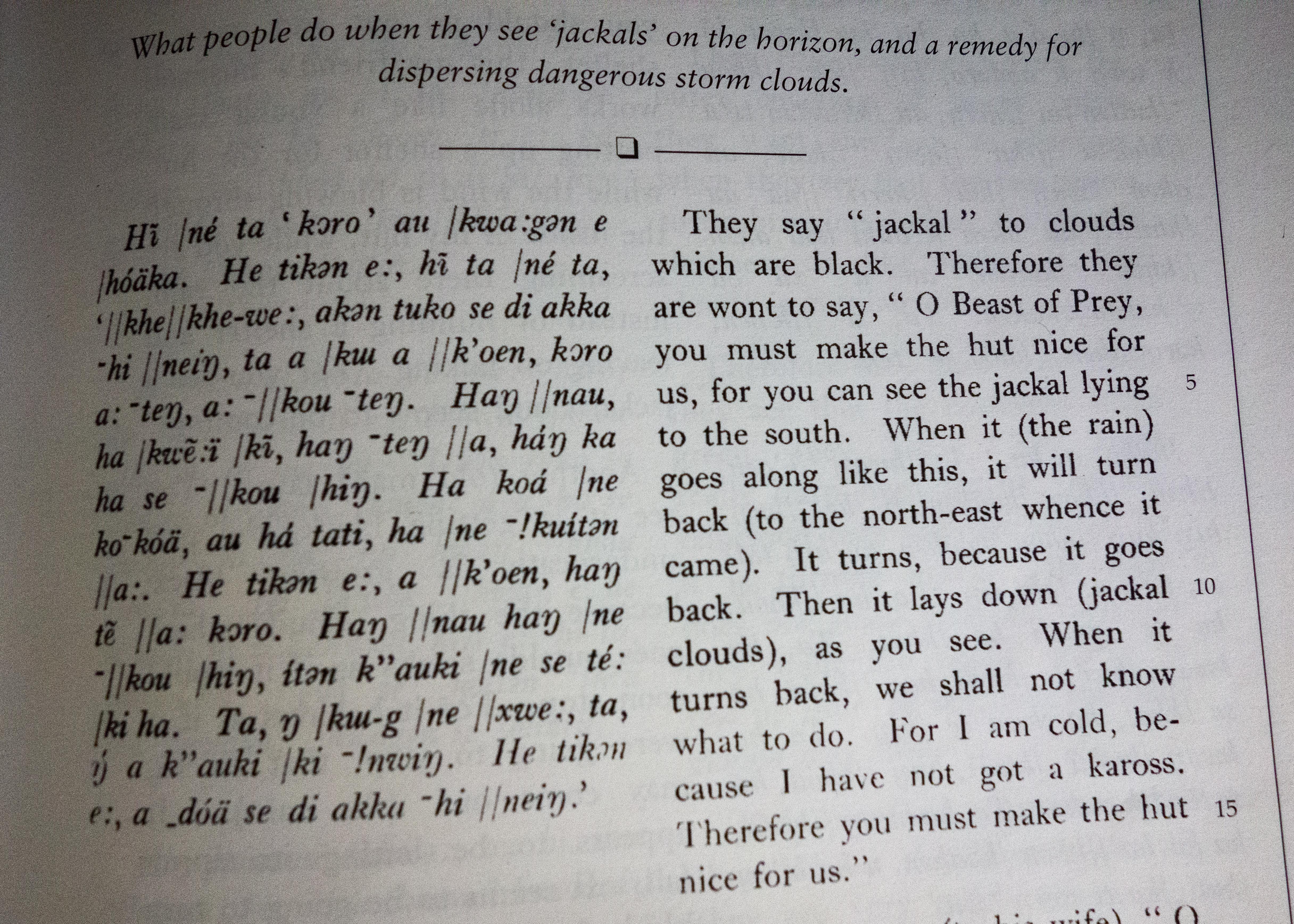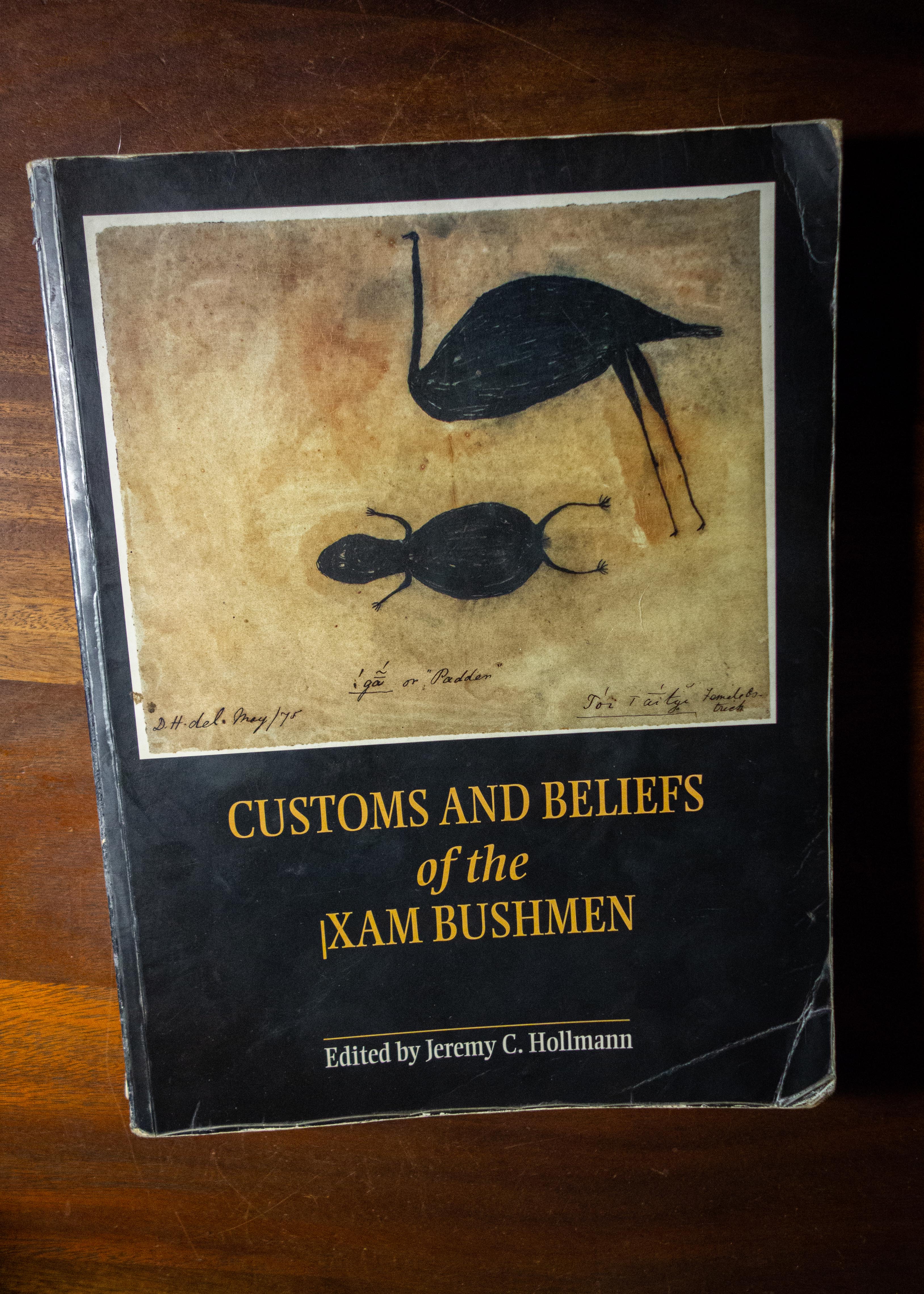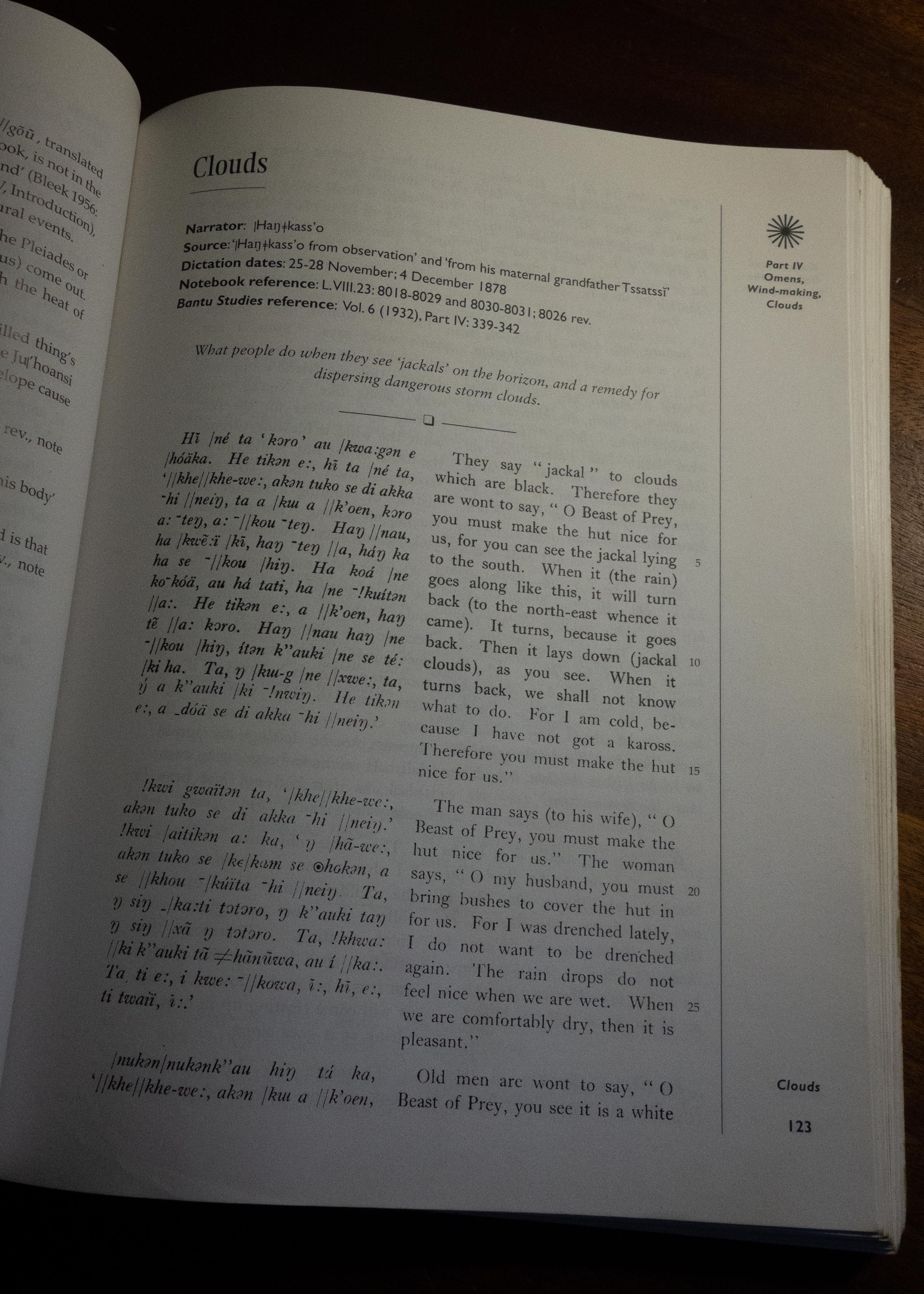


Dorothea Bleek (1873-1948), daughter of Wilhelm Bleek and Jemima Lloyd, was a scholar of ‘Bushman’ languages’. Amongst her many other research activities she sought out opportunities to publish and publicise the work of the ǀxɑm narrators that her father and aunt had transcribed and translated (see Digital Bleek and Lloyd).
Dorothea Bleek approached the journal Bantu Studies (now African Studies) to publish a series of collected narrativesin which the ǀxɑm narrators spoke about their worldview and practices — what Bleek (1875) and Lloyd (1889) classified in their reports as ‘Customs and Superstitions’. Between 1931 and 1936 selected narratives were published in 9 parts under the title Customs and Beliefs of the |xam Bushmen.
Customs and Beliefsof the ǀxɑm is a large and complex collection of 115 narratives drawn from 52 notebooks in the Bleek and Lloyd Collection. For decades it was one of only two scholarly publications — the other was Bleek and Lloyd’s (1911) Specimens of Bushman Folklore — in which portions of the narratives were published in ǀxɑm alongside the English translation. These publications have played a central role in the study of rock art and in other disciplines.
In her biography, Dorothea Bleek: A Life of Scholarship, Jill Weintroub (2015: 39) writes that ‘the texts were presented in accordance with Dorothea’s stated wish that the translations be ‘simply offered to the world, without comments or interpretations in whatsoever form’’. The idea that a text can ‘speak for itself’ is, of course, problematic. The act of translation is one of transformation. The texts were prepared to make them accessible, in English, to an audience of scholars and other interested readers. In preparing the narratives Dorothea sacrificed the ǀxɑm idiom for more familiar English modes of speech, as was also the case with Specimens of Bushman Folklore. And while Dorothea’s invaluable translations are always closely aligned to the ǀxɑm text, she did intervene in a number of ways.
She omitted ǀxɑm comments and other details that she did not consider directly relevant to the narrative. References to urination and genitalia were excised. Following the convention established by her father and Lucy Lloyd, her aunt, Dorothea Bleek continued the use of ‘Elizabethan archaisms’ (Wessels: 2010: 3), for example, thee, thou, ye, art, didst, dost, shalst, shouldst. Certain idiomatic ǀxɑm ways of saying, such as expressing hyperbole in the negative (‘not a little large’ rather than ‘very large’) are often overridden in favour of more idiomatic English. The meanings of ǀxɑm words as given in the Bushman Dictionary and in examples from the Notebooks suggest subtleties in meaning that were elided in the Customs and Beliefs narratives.
In this way, and with the best of intentions, ǀxɑm-ka ǂkɑkkən (ǀxɑm speech, or language) has been suppressed. The content of the ǀxɑm ideas being communicated cannot be separated from the ways in which these are formulated, the language, its vocabulary, grammar and idiom. In addition, the ǀxɑm narrators spoke about ideas and beliefs that neither the Bleek’s nor Lucy Lloyd understood. Dorothea Bleek’s insistence that there should be no comments or introduction ‘whatsoever’ to her edited and conflated translations meant that readers were thrown into the deep end of this pool of narratives without any introduction to or understanding of the context of the narratives.
A close reading of the published text in conjunction with the notebook text (ǀxɑm and English) shows how Dorothea Bleek’s translations sometimes weave together several individual statements in ǀxɑm-ka ǂkɑkkən to create a single complex English sentence. In the process however, elements of ǀxɑm-ka ǂkɑkkən (ǀxɑm speech) are lost.
The ǀxɑm narratives are oral-performative in nature and many elements of ǀxɑm-kɑ ǂkɑkkən are not readily translatable. Lloyd writes of ‘long discourses’ (Lloyd 1889: item 22, p. 19) and ‘… a great deal of repetition’ (1889: item 68, p. 10) while Wilhelm Bleek refers to ‘… interminable speeches by the jackal’ (1875: item 13, p. 12 (31)) and ‘an almost interminable description of springbok hunting’ (1875: item 112, p. 19).
Nevertheless, Dorothea Bleek herself acknowledged the prominence of ‘repetition’ (re-iteration might be a better term) in ǀxɑm-kɑǂkɑkkən : ‘Repetition seems the most striking feature of Bushman speech. Every part of a story is generally told over and over again with slight alterations in the forms of speech’ (Bleek 1929). A a careful reading of these ‘repetitions’ suggests that instead of ‘slight alterations’ each iteration is subtly different and each time a little new information is added. The narratives grow incrementally.
In researching the Customs and Beliefs narratives the English text that Dorothea omitted has been reincorporated in a form that conforms more closely with the verbal style of delivery of ǀxɑm-kɑǂ kɑkkən, as advocated by José de Prada-Samper (2014). This takes the form of ‘a short-line ethnopoetic arrangement’ of the English translations of the ǀxɑm narratives. Dorothea Bleek (1929: 172) pointed out ǀxɑm-kɑ ǂ kɑkkən ‘…is broken up into small clauses, joined either by connectives which precede the subject, by relatives, or by the meaning’. Written English, on the other hand comprises ‘longer, grammatically coherent sentences’ (Lewis-Williams 2000: 38 cited in De Prada-Samper 2014: 619).
This alternative arrangement of the text is not intended to represent ǀxɑm-kɑǂkɑkkən as poetry. It is rather a means to approach the ǀxɑm way of speaking more closely. Each line of text is a clause or unit of meaning on its own. The reader becomes aware of how the narrative develops clause by clause. A short example of omitted ‘repetitive’ text arranged according to De Prada-Samper’s delineation illustrates this.
First, the notebook translation and its punctuation as given in the notebook is presented in the usual manner (A2.1.052: 4145–4157, The tale of a wise person/sorceress, what she said, when she talked with us). The ‘snoring’ refers to the ǀxɑm practice of sniffing sickness out of a patient into the body of the healer, who then expels the sickness:
And it seemed/used to seem as if she could not ‘snore’; and the people used to say that she did not ‘snore’ a person well; because she was one who had been rendered weak. This was why the thing seemed as if she did not ‘snore’ a person well. For she was one who had been rendered weak. This was why the thing seemed as if she did not ‘snore’ a person well. For, she had been a sorceress who had been able even if a person were lying dying, to snore up the person who had lain a long time.
Here the same text is presented using the ethnopoetic style of delineation:
And it seemed/used to seem as if she did/could not ‘snore’
And the people were used to say that she did not ‘snore’ a person well
Because she was one who had been rendered weak
This was why the thing seemed as if she did not ‘snore’ a person well
For she had been a sorceress who had been able
Even if a person were lying dying
To snore up the person who had lain a long time
Aside from the changes to the lineation and the omission of punctuation, no alterations were made to the English — the delineation alone enhances the reader’s perception of the reiteration and elaboration of phrases in the narratives.
Customs and Beliefs is an important text. Like most of the published literature from the Bleek and Lloyd Collection, however, the focus has been on the English translations rather than on the ǀxɑm. One obvious reason is that readers are not familiar with ǀxɑm-kɑǂkɑkkən and their primary interest is on getting information in English from the text. There is however a cost attached to relying exclusively on Dorothea Bleek’s translated text. Meaning and expression are masked, understanding and insight are reduced. One does not have to speak or read |xam to access the language, however. With the help of the Bushman Dictionary (Bleek 1956), the arrangement of parallel texts in Customs and Beliefs — one column in ǀxɑm-kɑǂkɑkkən, the other in English — makes it possible to move between the two languages and identify salient words and phrases. The research into Customs and Beliefs described here involves close readings of ǀxɑm words and phrases, on behalf of others, for discrepancies between ǀxɑm-kɑǂkɑkkən and English the exploration of the contexts of the utterances. In this way readers will be better equipped to identify, understand and appreciate the texts.
References
BLEEK, D.F. 1929. Bushman Grammar: a grammatical sketch of the language of the ǀxɑm-ka ǃkˀe. Zeitschrift für Eingeborenen-Sprachen20: 161–174
BLEEK, D.F. 1956. Bushman dictionary. New Haven, Connecticut: American Oriental Society
BLEEK, W.H.I. 1875. Dr Bleek’s second report concerning Bushman researches, with a short account of the Bushman native literature collected. Government Printer: Cape Town
BLEEK, W.H.I. & LLOYD, L.C. 1911. Specimens of Bushman folklore. London. George Allen & Company
DE PRADA-SAMPER, J.M. 2014. Di-xεrretən and the lioness’: text and landscape of a ∣Xam narrative. Critical Arts: A South-North journal of Cultural and Media Studies 28(4): 610-630. doi: 10.1080/02560046.2014.929219
LEWIS-WILLIAMS, J.D. 2000. Stories that float from afar: ancestral folklore of the San of Southern Africa. Cape Town: David Philip
LLOYD, L.C. 1889. A short account of further Bushman material collected. London: David Nutt
WEINTROUB, J. 2015. Dorothea Bleek: a life of scholarship. Johannesburg: Wits University Press
WESSELS, M. 2010. Bushman Letters: interpreting /xam narrative. Johannesburg: Wits University Press